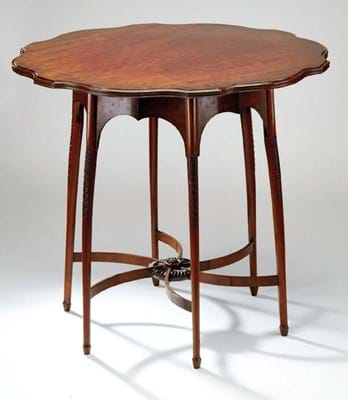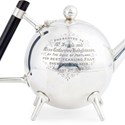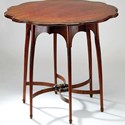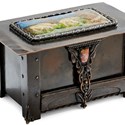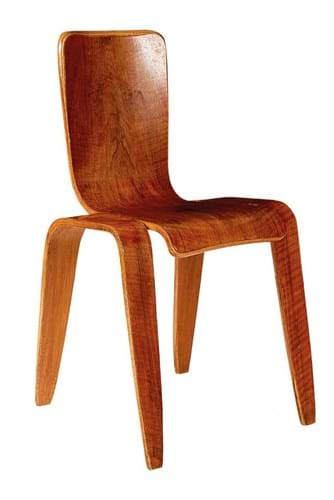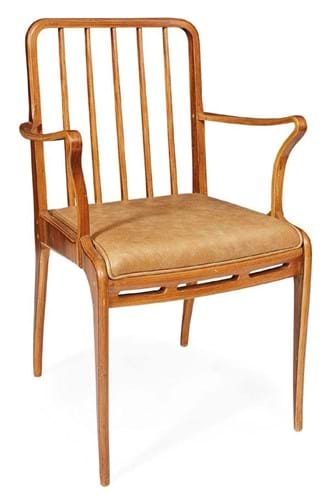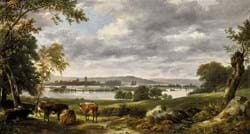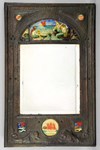From CR Mackintosh to Jessie M King, Scotland’s sons and daughters have contributed hugely to this market.
Christopher Dresser (1834-1904) was of Yorkshire stock and educated in London but, as the cataloguer reminded us, he too was born in Glasgow. At L&T’s October 25 sale in Edinburgh the eight lots he designed and three others attributed to him all found buyers.
Topping the section was a teapot from the series he designed for Sheffield maker James Dixon.
While much of Dresser’s teapot designs were rooted in Japanese art, this 5½in (14cm) tall ebony-handled teapot equally had echoes of those made in Scotland in the early 18th century. Famously, despite Dresser’s enthusiasm for mass production, these were expensive. Even the electroplate version of this rare design cost £1/3s/10d in 1882, making it unusually expensive.
The L&T example, hallmarked Sheffield 1882, was a rare solid silver version. It was probably made for the Duke of Portland and, according to an inscription, was presented by him to prize-winning horse breeders in 1887.
Stamped with the maker’s mark and facsimile signatures Chr. Dresser and JD & S, it sold within estimate to an English collector at £12,000.
Famous name
Probably the most famous name in Scottish design, Charles Rennie Mackintosh (1862-1928) also featured among the metalware – a rare set of six plated dessert spoons made for his famous Glasgow client, Miss Cranston’s Willow Tearooms.
Made c.1905, the 7in (18.5cm) spoons with trefoid ends doubled the mid-estimate to sell at £3600.
With none of the famous chairs he made for the tearooms on offer (a pair of ladderbacks took a hammer £90,000 at the corresponding L&T sale three autumns ago), Rennie Mackintosh was represented among the furniture by an ‘attributed to’ c.1900 stained pine, reverse breakfront cabinet.
Part of the office furniture at the Glasgow School of Art for most of the 20th century, the 4ft 2in tall x 5ft 9in wide (1.27 x 1.75m) piece featured panelled doors and drawers flanked by two banks of 10 drawers.
From a private source, it sold to a collector at £7600 against an undisclosed estimate.
The top-selling furniture item – and a reminder that this was emphatically not just a Scottish sale – was a c.1900 Howard & Son and William Morris sofa. Furniture by the London firm Howard & Son remains in high demand but it first established its reputation as upholsterers.
And a key factor in propelling the 6ft 2in (1.89m) mahogany-framed sofa way beyond the conservative £1000-1500 estimate was the covering: Honeycomb silk and wool fabric designed by Morris.
Consigned by descendants of its first owner, the sofa went to a private buyer at £11,000.
Another Morris piece was a c.1895 Arts & Crafts mahogany occasional table with a 3ft 6in (76cm) diameter circular top, on slightly curved legs linked by stretchers at the centre with a carved sunflower.
Stamped with the maker’s mark Morris & Co, 449 Oxford Street, it was designed by one of the company’s frequent designers, George Jack (1855-1931). Born in the US, Jack was five when his widowed mother took him back to Scotland. He trained there before moving to London in 1880 to work with the architectural practice of Arts & Crafts pioneer Philip Webb.
Jack’s table, estimated at £2000- 3000, sold to an English buyer at £9000.
Morris major
The name Morris – this time the Glasgow furniture maker Harris Morris – was linked to another £9000 purchase.
In 1947 Neil Morris asked Sir Basil Spence to collaborate on a range of plywood furniture including the Bambi chair and Cloud sofa. The story of how this evolved into the highly expensive Allegro dining suite is revisited whenever an item brings high prices at auctions today.
In Edinburgh, an armchair from the suite in laminated wood and a Bambi stacking chair in laminate and Honduras mahogany came from the same private collection.
The Allegro chair was estimated at £2500-3500 and sold to a private bidder at £9000. As auctioneer John Mackie pointed out in the catalogue, a single Allegro seat was advertised in 1950 at £31 18s 3d, nearly a third of the average annual British income, so one can say that the hammer price had roughly paralleled wage inflation since then. The Bambi chair sold at £2200 against a guide of £400-600.
Upper-end demand
With collectors taking most of the higher-priced lots, about 70% of the 600 lots got away to a hammer total of £365,000.
“I think that the sale demonstrated, with a few notable exceptions, that the market has real strength at the upper end, but is a little less reliable in the mid-range,” said Mackie.
Examples of mid-range pieces falling short of hopes included a c.1930 gentleman’s oak dressing table by Cotswolds disciple Peter Waals (1870-1937) and a c.1903 chequer banded mahogany writing cabinet by architect, sculptor and designer William James Neatby. Each was estimated at £4000-6000 and sold at £3800.
However, a trio of the boxes and caskets so loved by Arts & Crafts designers got away well. One was a c.1890 pictorial workbox catalogued as Birmingham School. With an ogee lid, the 20in (51cm) wide box had inlaid sides with penwork Pre- Raphaelite-style panels illustrating William Morris poems. Estimated at £3000- 5000, it sold at £7000.
A c.1910 silver and enamel pot pourri casket and cover by John Williams, a founder of the Guild of Handicrafts, had a pierced cover centred by an enamelled rose and the inscription Gather Ye Rosebuds While Ye May among entwined briars. It sold to a Scottish collector on the lower £4000 estimate.
Most decorative of the trio was the c.1890 copper and enamel casket by Frederick James Shields.
Born into extreme poverty in Hartlepool, Shields made his way as an engraver, befriending Madox Brown and Rossetti, who gave him space in his own studio.
The 6¼in (16cm) wide casket was enamelled with a faun playing pipes to grazing sheep on the lid and stamped to the clasp with a monogram. It sold above estimate to a Scottish collector at £3600.
Wemyss highlights
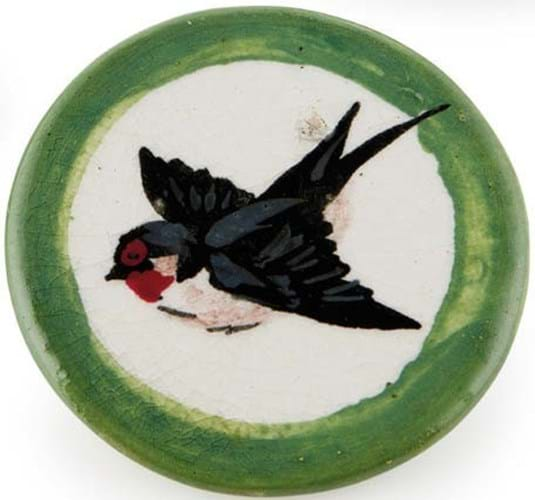
Early 20th century Wemyss button – £3000 at Lyon & Turnbull.
Finally, no Scottish sale would be complete without reference to Wemyss. The market is far from the peaks of 20 years ago but a large black and white pig, 18in (46cm) long decorated by Joe Nekola post-1930 took £3600 against a £1000-1500 estimate, and a small 6in (15cm) porker c.1900 covered in a rare lavender blue glaze left a £600-800 estimate behind selling at £3800.
Setting what Mackie believes must be a near record was an early 20th century Wemyss button, 1¼in (3.2cm) diameter, painted with a swallow within a black band. Offered with two slightly larger celadon oval buttons, it was estimated at £600- 800 but sold at £3000.



